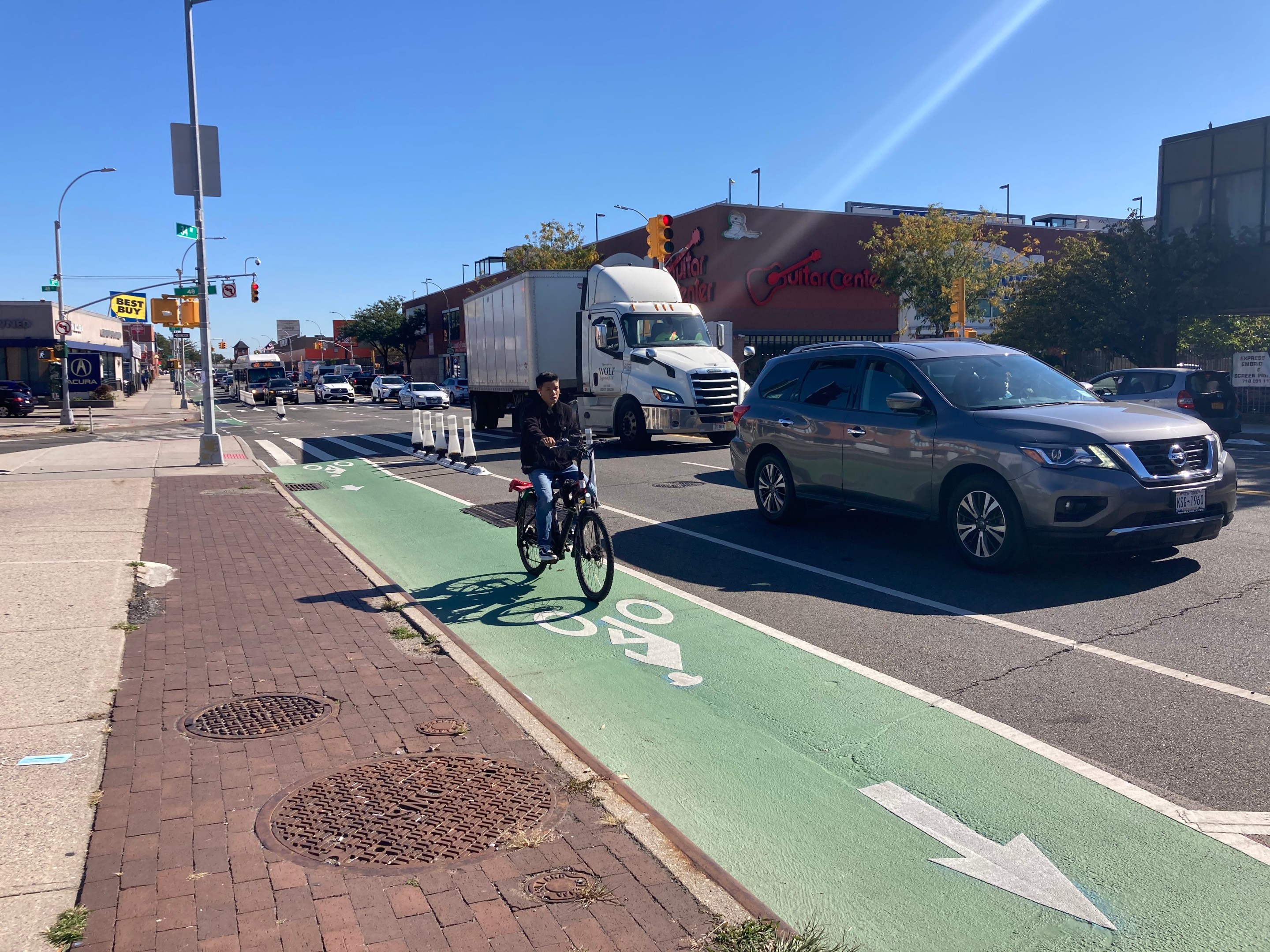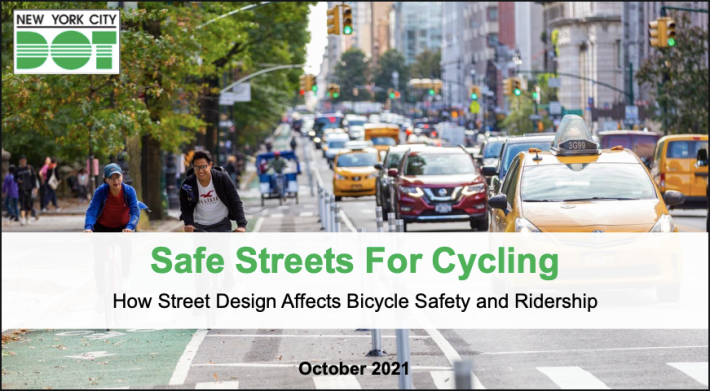So remind us again? How come every street doesn't have a bike lane?
A new report from the Department of Transportation reveals that a new bike lane — whether protected or simply painted — decreases the risk of cyclist injury by 32 to 34 percent, results that make a strong case that every street should be improved with some sort of bike safety infrastructure, especially physical protection.
But unfortunately that's not the manner in which the city intends to implement the findings of the new report, Safe Streets For Cycling: How Street Design Affects Bicycle Safety and Ridership.
Instead of committing to installing more bike lanes everywhere, DOT is delaying projects — like plans for a protected bike lane on Fifth Avenue — and in fact, is even going in the wrong direction. Last month, an e-bike rider was killed on a Queens roadway that that the city had once built as a “protected” bike lane, but then downgraded to mere paint after drivers destroyed all the flex-posts that once secured the lane.
And advocates say that touting both conventional paint bike lanes and protected bike lanes in the same breath is a slap in the face to riders, especially when previous studies show that protected bike lanes have the support of 68 percent of voters (including majorities in all boroughs), and help close the gender gap in cycling, which the DOT is well aware of.
"Survey after survey shows that protected bike lanes are popular and one of the best ways to shrink cycling’s gender gap. Without physical protection — and even sometimes with — New York's bike lanes are overrun with illegal parking, which as we saw in the case of Madison Lyden, can be deadly," said Cory Epstein, spokesperson for Transportation Alternatives, referencing the fatal crash back in 2018 when an Uber driver stopped illegally in the then-unprotected Central Park West bike lane, forcing the 23-year-old Australian tourist into traffic, where she was then run over by a driver. "By physically reclaiming space from cars, protected bike lanes can be used as a road diet to build slower streets, prevent speeding, and protect all road users like motorists and pedestrians, too.
"Paint is not protection and we are glad that DOT will be building 250 miles of protected bike lanes in NYC over the next five years as the Streets Master Plan requires," Epstein added.
The good news is that the new report can once again dull the blade of community board members who claim without evidence that bike lanes make roadways more dangerous. Citing injury data from more than 100 miles of on-street bike lanes, the city found that protected bike lanes reduce the risk of injury by 34 percent, and that mere painted bike lanes reduced injury by 32 percent.
“Both work, both help, we’re committed to doing both. We are committed to making cyclists safer, better and promoting it not just on the safety aspect but because it’s a critical part of helping to reduce reliance on private automobiles. We are making use of all available tools to encourage cycling, and encourage alternative modes of transportation of the car,” said DOT Commissioner Hank Gutman, next to a newly installed protected bike lane on Northern Boulevard last week.
The new study specifically revealed:
- Cyclist risk of injury fell by over 60 percent after bike lanes were installed on some of the highest-risk streets
- Cycling volumes increased by more 50 percent after the installation of both new conventional and protected bike lanes, though a general bike boom took off throughout the whole city last year, leading to a 33 percent increase in trips over the East River bridges compared to 2019, as Streetsblog has reported
- Protected bike lanes on one-way streets wider than 60 feet provide the greatest risk reduction at 35 percent
- Conventional bike lanes installed on narrow (40-feet wide or less) one-way streets also provide a 35 percent reduction in injury risk
- Shared lanes provided only an 18-percent reduction to cyclist risk of injury
To calculate “bicyclist risk” DOT says it divided “bicyclist injuries per mile” by the “estimated bicyclist volume,” which it derived by comparing bike counters on city-owned bridges like the Pulaski, Williamsburg, and Queensboro, and on major protected bike lanes like Kent Avenue, and Citi Bike daily usage — numbers that are too vague to tell the whole story, advocates say.
It’s hard to know what to make of this, since 🚲 volume data is so sparse outside of CitiBike (and even CitiBike has no routing data) and the slim summary here doesn’t show “estimated bike volume” on any kind of street/corridor basis pic.twitter.com/AkLLOiLq9W
— Bike New York (@bikenewyork) October 22, 2021
In boroughs with large enough protected bike lane sample sizes, DOT says Queens saw the biggest reduction (40 percent) in cyclist risk, while Manhattan saw a 26 percent reduction. And on conventional bike lanes, the Bronx and Brooklyn have risk reductions of 34 percent, while Manhattan was 28 percent, according to the study.
But advocates are not convinced. On the very same day DOT was touting its so-called protected and paint bike lanes, Queens Council Member Jimmy Van Bramer joined advocates to install a ghost bike for the slain e-bike rider, 32-year-old Thomas Panto, who was killed on Honeywell Street on Oct. 11 after a teenager in a 4,000-plus-pound Chevy pickup truck driving the wrong way on a dangerous Queens overpass struck Panto after veering into the northbound lane.
"Paint is not protection. Today we remember Thomas Panto, a cyclist who was struck and killed on what was & should’ve remained a protected bike lane," the pol wrote on Twitter. "I’m angry because the NYC DOT has it in their power to save lives, instead we’re here placing a ghost bike in Panto’s honor."
Paint is not protection. Today we remember Thomas Panto, a cyclist who was struck and killed on what was & should’ve remained a protected bike lane. I’m angry because the @NYC_DOT has it in their power to save lives, instead we’re here placing a ghost bike in Panto’s honor. pic.twitter.com/VSMNgx2GaY
— Jimmy Van Bramer (@JimmyVanBramer) October 20, 2021
And it's not the first both the city’s protected and conventional bike lanes have come under fire, including the very bike lane on Northern Boulevard that DOT was touting. Streetsblog reported back in March that the bike lane had nearly all but disappeared after the Department of Sanitation destroyed the flexible delineators as it plowed the street for cars, drawing attention to the dangers of such flimsy protection that activists warn do little to actually protect riders from speeding and reckless motorists.
Elsewhere in Queens on Crescent Street, cyclists have similarly sounded the alarm about the two-way bike lane’s lack of physical barriers to keep riders safe from speeding drivers. Last November, the driver of a massive beer distribution truck fatally struck 35-year-old scooter rider Alfredo Cabrera Liconia on Crescent Street near Astoria Boulevard. Video from the scene shows the truck’s front wheels in the green paint, which, activists said at the time, would be impossible if the lane was truly protected.
Gutman has said that the city installs what’s feasible based on the location, whether it’s a more concrete jersey barrier or flexi-post.
“It depends on the place. In some places jersey barriers are appropriate and other bollards do the trick, the team studies it, studies the location,” he said.
When asked whether the safety report would be in the impetus for the DOT to roll out bike lanes on every city street — given that the agency has confirmed that injuries drop — Gutman deflected. A spokesman for the agency later said, "We will continue to do more."







